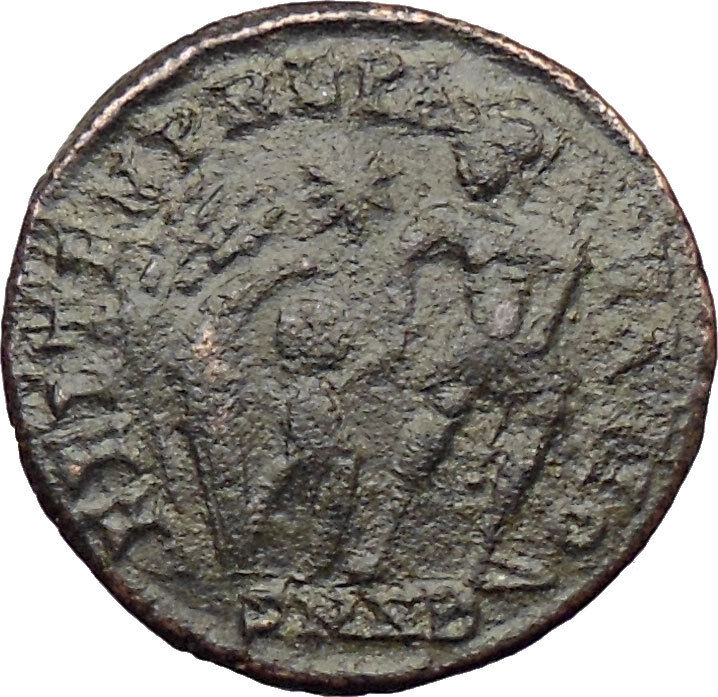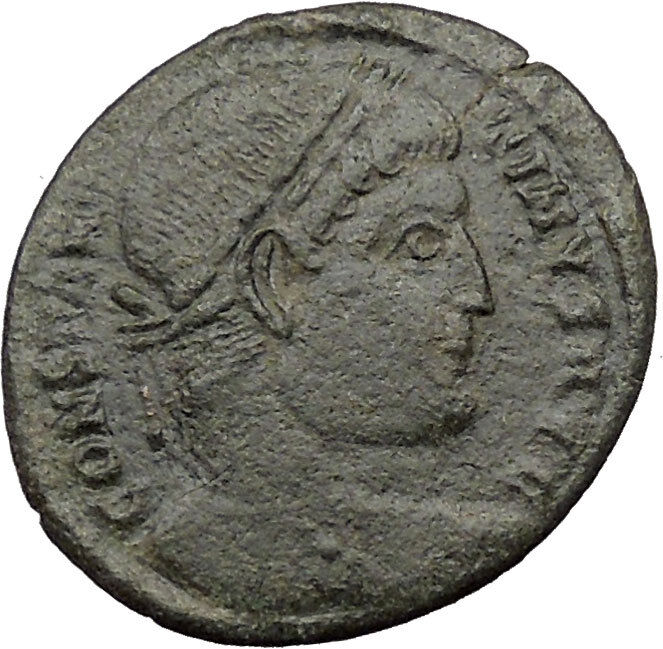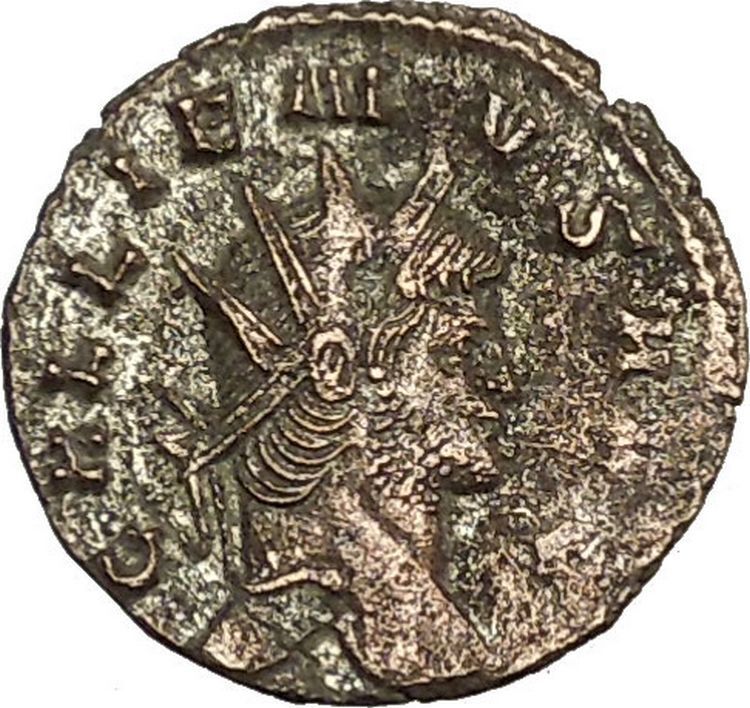|
Licinius I
–
Roman Emperor
308-324 A.D. –
Bronze AE3 17mm (2.96 grams) Treveri (Trier) mint: 318/319 A.D.
Reference: RIC 210; C 97
IMP LICINIVS AVG, laureate and cuirassed bust right
IOVI CONSERVATORI AVG Exe: STR, Jupiter holding sceptre and thunderbolt, on
eagle standing right.
* Numismatic Note: Rare type.
You are bidding on the exact item pictured,
provided with a Certificate of Authenticity and Lifetime Guarantee of
Authenticity.
Jupiter is usually thought to have originated as a sky god. His identifying
implement is the
thunderbolt
, and his primary sacred animal is
the eagle, which held precedence over other birds in the taking of
auspices
and became one of the most

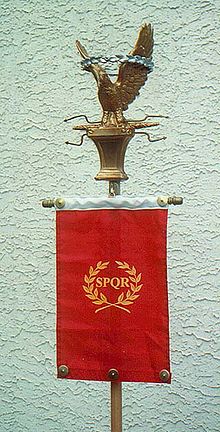 common common
symbols of the
Roman army
(see
Aquila
). The two emblems were often combined to
represent the god in the form of an eagle holding in its claws a thunderbolt,
frequently seen on Greek and Roman coins. As the sky-god, he was a divine
witness to oaths, the sacred trust on which justice and good government depend.
Many of his functions were focused on the
Capitoline
(“Capitol Hill”), where the
citadel
was located. He was the chief deity of
the
early Capitoline Triad
with
Mars
and
Quirinus
. In the
later Capitoline Triad
, he was the central
guardian of the state with
Juno
and
Minerva
. His sacred tree was the oak. The
Romans regarded Jupiter as the
equivalent
of the Greek
Zeus, and in
Latin literature
and
Roman art
, the myths and iconography of Zeus
are adapted under the name Iuppiter.
An aquila, or eagle, was a prominent symbol used in
ancient Rome, especially as the
standard
of a
Roman legion
. A
legionary
known as an
aquilifer
, or eagle-bearer, carried this
standard. Each legion carried one eagle. The eagle was extremely important to
the Roman military, beyond merely being a symbol of a legion. A lost standard
was considered an extremely grave occurrence, and the Roman military often went
to great lengths to both protect a standard and to recover it if lost; for
example, see the aftermath of the
Battle of the Teutoburg Forest
, where the
Romans spent decades attempting to recover the lost standards of three legions.
Licinius I (Latin:
Gaius Valerius Licinianus Licinius Augustusc.
263 – 325), was
Roman Emperor
from 308 to 324. For the majority
of his reign he was the colleague and rival of
Constantine I
, with whom he co-authored the
Edict of Milan
that granted official toleration
to Christians in the Roman Empire. He was finally defeated at the
Battle of Chrysopolis
, before being executed on
the orders of Constantine I.

Sculptural portraits of Licinius (left) and his rival
Constantine I
(right).
Early reign

Coin of Licinius I.
Born to a Dacian
peasant family in
Moesia
Superior, Licinius accompanied his close
childhood friend, the future emperor
Galerius
, on the Persian expedition in 298. He
was trusted enough by Galerius that in 307 he was sent as an envoy to
Maxentius
in
Italy
to attempt to reach some agreement about
his illegitimate status. Galerius then trusted the eastern provinces to Licinius
when he went to deal with Maxentius personally after the death of
Flavius Valerius Severus
.
Upon his return to the east Galerius elevated Licinius to the rank of
Augustus in the West
on November 11, 308. He
received as his immediate command the provinces of
Illyricum
,
Thrace
and
Pannonia
. In 310 he took command of the war
against the Sarmatians
, inflicting a severe defeat on them
and emerging victorious. On the death of Galerius in May 311, Licinius entered
into an agreement with
Maximinus II
(Daia) to share the eastern
provinces between them. By this point, not only was Licinius the official
Augustus of the west, but he also possessed part of the eastern provinces as
well, as the
Hellespont
and the
Bosporus
became the dividing line, with
Licinius taking the European provinces and Maximinus taking the Asian.
An alliance between Maximinus and Maxentius forced the two remaining emperors
to enter into a formal agreement with each other. So in March 313 Licinius
married
Flavia Julia Constantia
, half-sister of
Constantine I
, at Mediolanum (now
Milan
); they had a son,
Licinius the Younger
, in 315. Their marriage
was the occasion for the jointly-issued “Edict
of Milan” that reissued Galerius’ previous edict allowing
Christianity
to be professed in the Empire,
with additional dispositions that restored confiscated properties to Christian
congregations and exempted Christian clergy from municipal civic duties.[8]
The redaction of the edict as reproduced by
Lactantius
– who follows the text affixed by
Licinius in Nicomedia
on June 14 313, after Maximinus’
defeat – uses a neutral language, expressing a will to propitiate “any Divinity
whatsoever in the seat of the heavens”.

Coin of Licinius
Daia in the meantime decided to attack Licinius. Leaving Syria with 70,000
men, he reached Bithynia
, although harsh weather he encountered
along the way had gravely weakened his army. In April 313, he crossed the
Bosporus
and went to
Byzantium
, which was held by Licinius’ troops.
Undeterred, he took the town after an eleven-day siege. He moved to Heraclea,
which he captured after a short siege, before moving his forces to the first
posting station. With a much smaller body of men, possibly around 30,000,[10]
Licinius arrived at
Adrianople
while Daia was still besieging
Heraclea
. Before the decisive engagement,
Licinius allegedly had a vision in which an angel recited him a generic prayer
that could be adopted by all cults and which Licinius then repeated to his
soldiers.[11]
On 30 April 313, the two armies clashed at the
Battle of Tzirallum
, and in the ensuing battle
Daia’s forces were crushed. Ridding himself of the imperial purple and dressing
like a slave, Daia fled to
Nicomedia
. Believing he still had a chance to
come out victorious, Daia attempted to stop the advance of Licinius at the
Cilician Gates
by establishing fortifications
there. Unfortunately for Daia, Licinius’ army succeeded in breaking through,
forcing Daia to retreat to
Tarsus
where Licinius continued to press him on
land and sea. The war between them only ended with Daia’s death in August 313.
Given that Constantine had already crushed his rival Maxentius in 312, the
two men decided to divide the Roman world between them. As a result of this
settlement, Licinius became sole Augustus in the East, while his brother-in-law,
Constantine, was supreme in the West. Licinius immediately rushed to the east to
deal with another threat, this time from the Persian
Sassanids
.
Conflict with
Constantine I
In 314, a civil war erupted between Licinius and Constantine, in which
Constantine used the pretext that Licinius was harbouring Senecio, whom
Constantine accused of plotting to overthrow him. Constantine prevailed at the
Battle of Cibalae
in
Pannonia
(October 8, 314).[6]
Although the situation was temporarily settled, with both men sharing the
consulship
in 315, it was but a lull in the
storm. The next year a new war erupted, when Licinius named
Valerius Valens
co-emperor, only for Licinius
to suffer a humiliating defeat on the plain of
Mardia
(also known as
Campus Ardiensis
) in
Thrace
. The emperors were reconciled after
these two battles and Licinius had his co-emperor Valens killed.
Over the next ten years, the two imperial colleagues maintained an uneasy
truce. Licinius kept himself busy with a campaign against the Sarmatians in 318,
but temperatures rose again in 321 when Constantine pursued some Sarmatians, who
had been ravaging some territory in his realm, across the Danube into what was
technically Licinius’s territory. When he repeated this with another invasion,
this time by the Goths
who were pillaging
Thrace
, Licinius complained that Constantine
had broken the treaty between them.
Constantine wasted no time going on the offensive. Licinius’s fleet of 350
ships was defeated by Constantine I’s fleet in 323. Then in 324, Constantine,
tempted by the “advanced age and unpopular vices” of his colleague, again
declared war against him, and, having defeated his army of 170,000 men at the
Battle of Adrianople
(July 3, 324), succeeded
in shutting him up within the walls of
Byzantium
.[6]
The defeat of the superior fleet of Licinius in the
Battle of the Hellespont
by
Crispus
, Constantine’s eldest son and
Caesar
, compelled his withdrawal to
Bithynia
, where a last stand was made; the
Battle of Chrysopolis
, near
Chalcedon
(September 18), resulted in Licinius’
final submission. While Licinius’ co-emperor
Sextus Martinianus
was killed, Licinius himself
was spared due to the pleas of his wife, Constantine’s sister, and interned at
Thessalonica
. The next year, Constantine had
him hanged, accusing him of conspiring to raise troops among the barbarians.
Character and legacy
Constantine made every effort to blacken the reputation of his imperial
colleague. To this end, stories began circulating about Licinius’s cruelty. It
was said that he had put to death Severianus, the son of the emperor Severus, as
well as Candidianus, the son of Galerius. To this was added the execution of the
wife and daughter of the Emperor
Diocletian
, who had fled from the court of
Licinius before being discovered at
Thessalonica
. Much of this can be considered
imperial propaganda on the part of Constantine.
In addition, as part of Constantine’s attempts to decrease Licinius’s
popularity, he actively portrayed his brother-in-law as a pagan supporter. This
was not the case; contemporary evidence tends to suggest that he was at least a
committed supporter of Christians. He co-authored the Edict of Milan which ended
the
Great Persecution
, and re-affirmed the rights
of Christians in his half of the empire. He also added the Christian symbol to
his armies, and attempted to regulate the affairs of the Church hierarchy just
as Constantine and his successors were to do. His wife was a devout Christian.
It is even a possibility that he converted. However,
Eusebius of Caesarea
, writing under the rule of
Constantine, charges him with expelling Christians from the Palace and ordering
military sacrifice, as well as interfering with the Church’s internal procedures
and organization. According to Eusebius, this turned what appeared to be a
committed Christian into a man who feigned sympathy for the sect but who
eventually exposed his true bloodthirsty pagan nature, only to be stopped by the
virtuous Constantine.
Finally, on Licinius’s death, his memory was branded with infamy; his statues
were thrown down; and by edict, all his laws and judicial proceedings during his
reign were abolished

In
ancient Roman religion
and
myth
, Jupiter (Latin:
Iuppiter) or Jove is the
king of the gods
and the
god of sky
and
thunder
. Jupiter was the chief deity of Roman
state religion throughout the
Republican
and
Imperial
eras, until the Empire
came under Christian rule
. In
Roman mythology
, he negotiates with
Numa Pompilius
, the second
king of Rome
, to establish principles of Roman
religion such as sacrifice.
Jupiter is usually thought to have originated as a sky god. His identifying
implement is the
thunderbolt
, and his primary sacred animal is
the eagle, which held precedence over other birds in the taking of
auspices
and became one of the most common
symbols of the
Roman army
(see
Aquila
). The two emblems were often combined to
represent the god in the form of an eagle holding in its claws a thunderbolt,
frequently seen on Greek and Roman coins. As the sky-god, he was a divine
witness to oaths, the sacred trust on which justice and good government depend.
Many of his functions were focused on the
Capitoline
(“Capitol Hill”), where the
citadel
was located. He was the chief deity of
the
early Capitoline Triad
with
Mars
and
Quirinus
. In the
later Capitoline Triad
, he was the central
guardian of the state with
Juno
and
Minerva
. His sacred tree was the oak.
The Romans regarded Jupiter as the
equivalent
of Greek
Zeus, and in
Latin literature
and
Roman art
, the myths and iconography of Zeus
are adapted under the name Iuppiter. In the Greek-influenced tradition,
Jupiter was the brother of
Neptune
and
Pluto
. Each presided over one of the three
realms of the universe: sky, the waters, and the underworld. The
Italic
Diespiter was also a sky god who
manifested himself in the daylight, usually but not always identified with
Jupiter. The
Etruscan
counterpart was
Tinia
and
Hindu
counterpart is
Indra
.
Relation to other gods
Archaic Triad
The Archaic Triad is a theological structure (or system) consisting of the
gods Jupiter, Mars and Quirinus. It was first described by Wissowa, and the
concept was developed further by Dumézil. The three-function hypothesis of
Indo-European society
advanced by Dumézil holds
that in prehistory, society was divided into three classes (priests, warriors
and craftsmen) which had as their religious counterparts the divine figures of
the sovereign god, the warrior god and the civil god. The sovereign function
(embodied by Jupiter) entailed omnipotence; thence, a domain extended over every
aspect of nature and life. The colour relating to the sovereign function is
white.
The three functions are interrelated with one another, overlapping to some
extent; the sovereign function, although essentially religious in nature, is
involved in many ways in areas pertaining to the other two. Therefore, Jupiter
is the “magic player” in the founding of the Roman state and the fields of war,
agricultural plenty, human fertility and welth.
Capitoline Triad
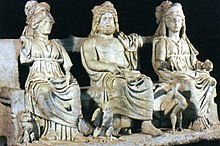
Capitoline Triad
The Capitoline Triad was introduced to Rome by the Tarquins. Dumézil thinks
it might have been an Etruscan (or local) creation based on Vitruvius’ treatise
on architecture, in which the three deities are associated as the most
important. It is possible that the Etruscans paid particular attention to
Menrva
(Minerva) as a goddess of destiny, in
addition to the royal couple Uni (Juno) and Tinia (Jupiter).[169]
In Rome, Minerva later assumed a military aspect under the influence of
Athena Pallas
(Polias). Dumézil argues that
with the advent of the Republic, Jupiter became the only king of Rome, no longer
merely the first of the great gods.
Jupiter and Minerva
Apart from being protectress of the arts and craft as Minerva Capta, who was
brought from Falerii, Minerva’s association to Jupiter and relevance to Roman
state religion is mainly linked to the
Palladium
, a wooden statue of Athena that could
move the eyes and wave the spear. It was stored in the penus interior,
inner penus of the aedes Vestae, temple of Vesta and considered the most
important among the
pignora imperii
, pawns of dominion, empire.[170]
In Roman traditional lore it was brought from Troy by Aeneas. Scholars though
think it was last taken to Rome in the third or second century BC.
Juno and Fortuna
The divine couple received from Greece its matrimonial implications, thence
bestowing on Juno the role of tutelary goddess of marriage (Iuno Pronuba).
The couple itself though cannot be reduced to a Greek apport. The association
of Juno and Jupiter is of the most ancient Latin theology.
Praeneste
offers a glimpse into original Latin
mythology: the local goddess
Fortuna
is represented as milking two infants,
one male and one female, namely Jove (Jupiter) and Juno. It seems fairly safe to
assume that from the earliest times they were identified by their own proper
names and since they got them they were never changed through the course of
history: they were called Jupiter and Juno. These gods were the most ancient
deities of every Latin town. Praeneste preserved divine filiation and infancy as
the sovereign god and his paredra Juno have a mother who is the primordial
goddess Fortuna Primigenia.[174]
Many terracotta statuettes have been discovered which represent a woman with a
child: one of them represents exactly the scene described by Cicero of a woman
with two children of different sex who touch her breast. Two of the votive
inscriptions to Fortuna associate her and Jupiter: ” Fortunae Iovi puero…” and
“Fortunae Iovis puero…”
In 1882 though R. Mowat published an inscription in which Fortuna is called
daughter of Jupiter, raising new questions and opening new perspectives
in the theology of Latin gods. Dumezil has elaborated an interpretative theory
according to which this aporia would be an intrinsic, fundamental feature
of Indoeuropean deities of the primordial and sovereign level, as it finds a
parallel in Vedic religion. The contradiction would put Fortuna both at the
origin of time and into its ensuing diachronic process: it is the comparison
offered by Vedic deity
Aditi
, the Not-Bound or Enemy of
Bondage, that shows that there is no question of choosing one of the two
apparent options: as the mother of the
Aditya
she has the same type of relationship
with one of his sons,
Dakṣa
, the minor sovereign. who represents the
Creative Energy, being at the same time his mother and daughter, as is
true for the whole group of sovereign gods to which she belongs. Moreover Aditi
is thus one of the heirs (along with
Savitr
) of the opening god of the Indoiranians,
as she is represented with her head on her two sides, with the two faces looking
opposite directions. The mother of the sovereign gods has thence two solidal but
distinct modalities of duplicity, i.e. of having two foreheads and a double
position in the genealogy. Angelo Brelich has interpreted this theology as the
basic opposition between the primordial absence of order (chaos) and the
organisation of the cosmos.
Janus
The relation of Jupiter to Janus is problematic. Varro defines Jupiter as the
god who has potestas (power) over the forces by which anything happens in
the world. Janus, however, has the privilege of being invoked first in rites,
since in his power are the beginnings of things (prima), the appearance
of Jupiter included.
Saturn
The
Latins
considered Saturn the predecessor of
Jupiter. Saturn reigned in
Latium
during a mythical
Golden Age
reenacted every year at the festival
of Saturnalia
. Saturn also retained primacy in
matters of agriculture and money. Unlike the Greek tradition of
Cronus
and Zeus, the usurpation of Saturn as
king of the gods by Jupiter was not viewed by the Latins as violent or hostile;
Saturn continued to be revered in his temple at the foot of the Capitol Hill,
which maintained the alternative name Saturnius into the time of Varro.[182]
A. Pasqualini has argued that Saturn was related to Iuppiter Latiaris,
the old Jupiter of the Latins, as the original figure of this Jupiter was
superseded on the Alban Mount, whereas it preserved its gruesome character in
the ceremony held at the sanctuary of the Latiar Hill in Rome which involved a
human sacrifice and the aspersion of the statue of the god with the blood of the
victim.
Fides
The abstract
personification
Fides (“Faith, Trust”) was one
of the oldest gods associated with Jupiter. As guarantor of public faith, Fides
had her temple on the Capitol (near that of Capitoline Jupiter).
Genius
Augustine quotes Varro who explains the genius as “the god who is in
charge and has the power to generate everything” and “the rational spirit of all
(therefore, everyone has their own)”. Augustine concludes that Jupiter should be
considered the genius of the universe.
G. Wissowa advanced the hypothesis that Semo
Sancus
is the genius of Jupiter.[189]
W. W. Fowler has cautioned that this interpretation looks to be an anachronism
and it would only be acceptable to say that Sancus is a Genius Iovius, as
it appears from the Iguvine Tables.
Censorinus cites
Granius Flaccus
as saying that “the Genius was
the same entity as the Lar” in his lost work De Indigitamentis. Dumézil
opines that the attribution of a Genius to the gods should be earlier than its
first attestation of 58 BC, in an inscription which mentions the Iovis Genius.
A connection between Genius and Jupiter would be apparent in
Plautus
‘ comedy
Amphitryon
, in which Jupiter takes up the
looks of Alcmena
‘s husband in order to seduce her: J.
Hubeaux sees there a reflection of the story that
Scipio Africanus
‘ mother conceived him with a
snake that was in fact Jupiter transformed. Scipio himself claimed that only he
would rise to the mansion of the gods through the widest gate.
It is noteworthy that among the Etruscan Penates there is a Genius
Iovialis who comes after Fortuna and Ceres and before Pales . Genius
Iovialis is one of the earthly Penates and not one of the Penates of
Jupiter though, as these were located in region I of Martianus Capella’ s
division of Heaven, while Genius appear in regions V and VI along with Ceres,
Favor (possibly a Roman approximation to an Etruscan male manifestation of
Fortuna) and Pales.
Victoria

Coin with
laureate
head of Jupiter (obverse)
and (reverse) Victory, standing (“ROMA” below in
relief
)
Victoria was connected to Iuppiter Victor in his role as bestower of
military victory. Jupiter, as a sovereign god, was considered as having the
power to conquer anyone and anything in a supernatural way; his contribution to
military victory was different from that of
Mars
(god of military valour). Victoria appears
first on the reverse of coins representing Venus (driving the quadriga of
Jupiter, with her head crowned and with a palm in her hand) during the first
Punic War. Sometimes, she is represented walking and carrying a trophy.
A temple was dedicated to the goddess afterwards on the Palatine, testifying
to her high station in the Roman mind. When
Hieron of Syracuse
presented a golden statuette
of the goddess to Rome, the Senate had it placed in the temple of Capitoline
Jupiter among the greatest (and most sacred) deities. Although Victoria played a
significant role in the religious ideology of the late Republic and the Empire,
she is undocumented in earlier times. A function similar to hers may have been
played by the little-known
Vica Pota
.
|






 common
common





